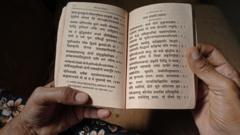India's PL-480 program, established in the 1950s, has inadvertently led to a significant enrichment of South Asian literature in some American libraries, notably at the University of Chicago. This initiative allowed countries like India to exchange local currency for U.S. grain during times of food scarcity, which in turn provided funding for U.S. universities to acquire relevant books and resources in Indian languages. As a result, collections at over two dozen institutions flourished, establishing hubs for South Asian studies in the United States.
The Regenstein Library at the University of Chicago stands as a crown jewel, housing more than 800,000 volumes focused on South Asia. Ananya Vajpeyi, an academic exploring these depths, reflects on her time spent among leading South Asia repositories, noting that no library could rival the University of Chicago's extensive South Asian literature. The library's collection owes its vastness to PL-480, a program started as part of Cold War diplomacy under President Eisenhower aimed at addressing both food insecurity and surplus grain in the U.S.
Initial funding from PL-480 enabled U.S. colleges to tap into India’s literary resources without financial strain, as local currency was used minimally. By sourcing books from India, Nepal, and Pakistan, over 633,000 items enriched U.S. collections. The establishment of a dedicated team in India to curate this collection exemplified the strategic approach to gathering literature amidst India's linguistic diversity.
Notably, the program faced its challenges. Early efforts concentrated on government publications before expanding to cover a broader spectrum of books and periodicals over five years. The selection process remained complex due to India's vast literary landscape, prompting the collaboration of booksellers who specialized in various language groups. Ultimately, the program underwent a recalibration, focusing more on research-level materials, leading to the removal of many fictional works.
However, this strategic resource gathering raises questions about the accessibility of South Asian literature in its homeland. Several librarians and academics, including Todd Michelson-Ambelang from the University of Wisconsin–Madison, have pointed out that the acquisition of such vast collections has potentially created gaps in the availability of resources for researchers in the Indian subcontinent. The notion of Western libraries as "colonial archives" emerges from their role in housing important texts while limiting access through copyright laws and institutional barriers for South Asian scholars.
With the PL-480 program’s end in the 1980s, the financial burden of acquiring resources shifted entirely to American libraries, which now invest heavily in maintaining and expanding their collections. Vajpeyi, reflecting on her own academic journey, emphasizes the contrast between the preservation and accessibility of materials in the U.S. compared to India’s challenges of resource loss and deterioration in domestic libraries.
While the initial outcome of the U.S. food aid program resulted in a rich cache of academic resources for American universities, it also sparked critical conversations about the impacts of this aid on South Asian literary heritage and the modern implications of such historical exchanges for future scholarship.




















